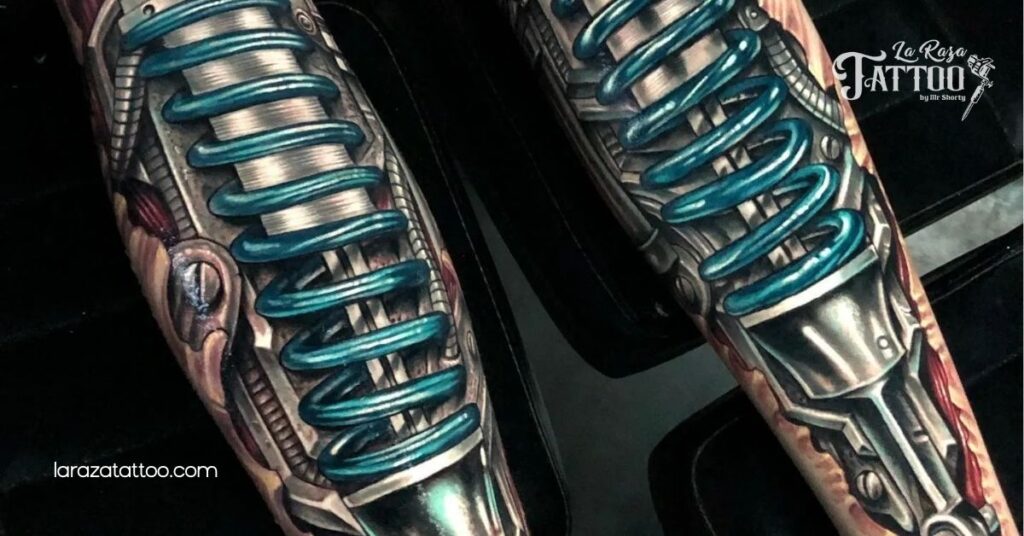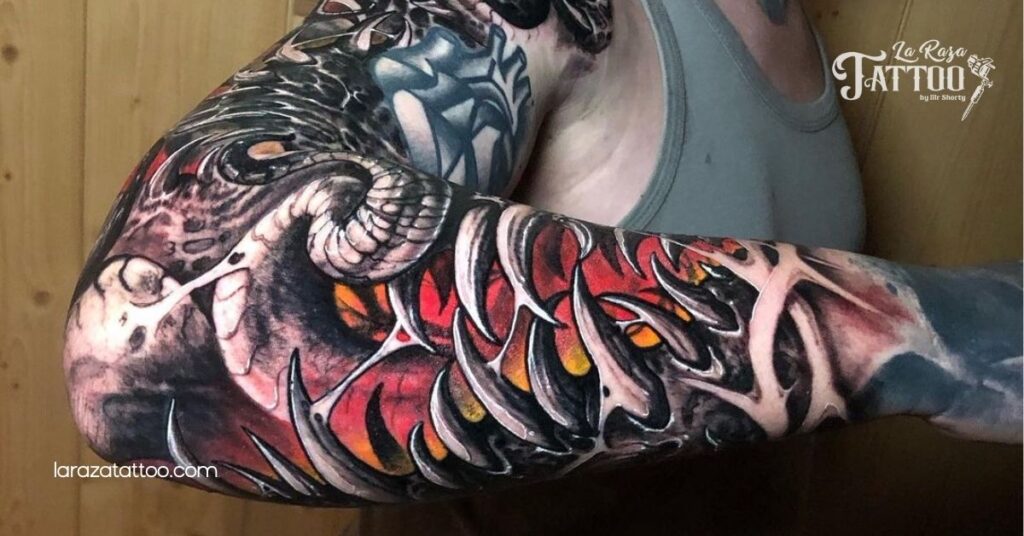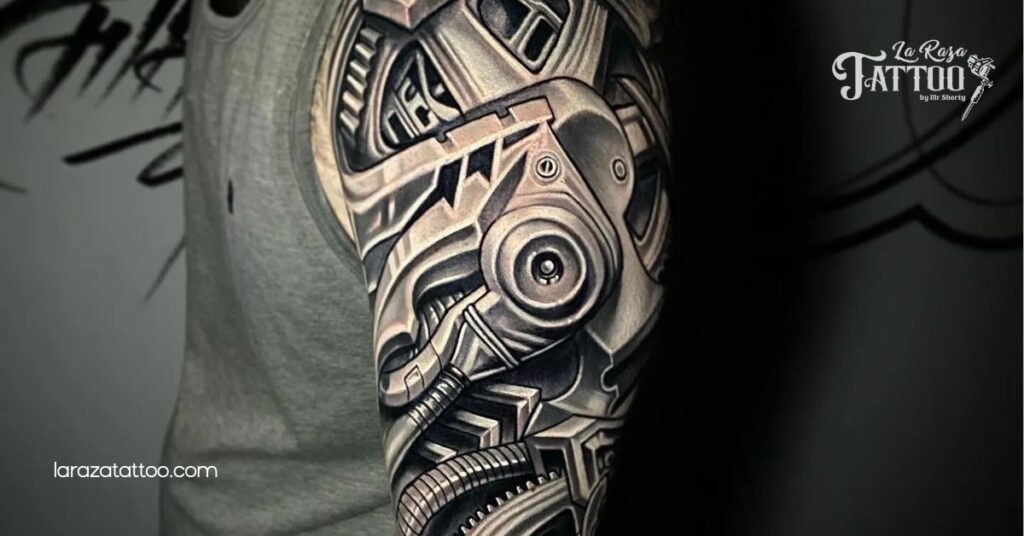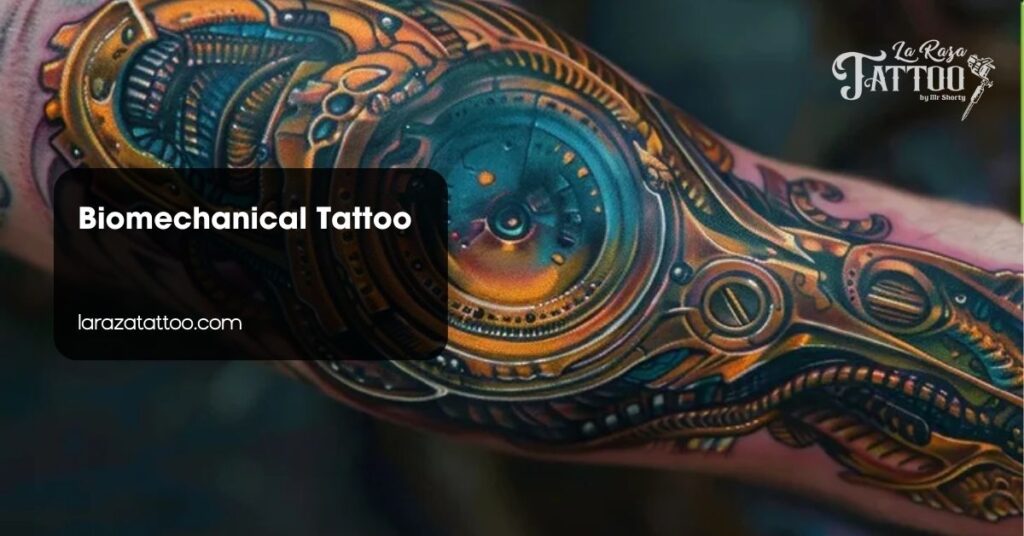Imagine wearing a piece of art that seamlessly blends the organic with the mechanical. Biomechanical tattoos do just that, creating stunning visuals that mimic the intricacies of machinery intertwined with the human form. This unique style not only captivates the eye but also tells a story of strength and innovation.
If you’re looking to make a statement that goes beyond traditional ink, biomechanical tattoos offer an extraordinary way to express your individuality. These designs can transform your skin into a canvas of futuristic aesthetics, showcasing your passion for technology and art. Jump into the industry of biomechanical tattoos and discover how they can redefine your personal style while sparking conversations wherever you go.
What Is a Biomechanical Tattoo?

Biomechanical tattoos combine organic and mechanical elements to create innovative designs. These tattoos are rooted in the idea of merging the human body with machinery, resulting in visually stunning artwork.
Definition of Biomechanical Tattoo
A biomechanical tattoo is an intricate art form that incorporates mechanical parts like gears and wires with anatomical forms. This unique style often resembles the appearance of machinery integrated seamlessly with human anatomy. You’ll find that the designs convey a sense of strength and complexity, showcasing an individual’s passion for both technology and artistry.
Origins of Biomechanical Tattoo Art
The origins of biomechanical tattoo art trace back to the late 20th century, gaining popularity through the works of tattoo artists like H.R. Giger. Giger’s influence is evident in the surreal and otherworldly aesthetics of biomechanical designs. Over time, the tattoo style evolved, attracting a diverse community of artists who embraced the fusion of organic and synthetic imagery. This evolution reflects a growing fascination with technology in contemporary culture, allowing individuals to express their uniqueness through intricate body art.
Features of Biomechanical Tattoos

Biomechanical tattoos have distinctive traits that make them stand out. You’ll notice a unique combination of organic and mechanical elements that create striking visuals.
Common Elements in Biomechanical Tattoo Designs
You’ll find that these tattoos often showcase human tissues, bones, and muscles intertwined with mechanical components. Gears, wires, robotic parts, and other machinery regularly feature in the designs. This fusion creates surreal effects that captivate viewers. Complex designs frequently require skilled artists capable of executing intricate details. Notably, the realism in these tattoos can mesmerize anyone who admires body art.
Color Schemes and Techniques Used
Shading is crucial in biomechanical tattoos, helping to create an illusion of depth and movement. Artists often use a limited color palette, favoring black and grey to enhance the three-dimensional look. Realistic shading techniques give the impression that mechanical parts are shifting beneath the skin. Also, some artists incorporate splashes of color, such as metallic tones, to emphasize certain elements. This blend of techniques results in visually compelling tattoos that resonate with both art and technology enthusiasts.
Popular Themes in Biomechanical Tattoos

Biomechanical tattoos often feature fascinating themes that merge human and mechanical elements, creating an captivating visual experience. One of the most prominent themes in this tattoo style is the fusion of human and machine.
Human and Machine Fusion
Human and machine fusion represents a core theme of biomechanical tattoos. This design showcases the blending of human anatomy with mechanical components, reflecting our increasing reliance on technology. Viewers often see intricate details like gears, cables, and pistons integrated into the human body, creating the illusion that machinery is part of the wearer. You might encounter designs with robotic limbs, mechanical hearts, or cyborg-like figures that highlight this connection between humanity and innovation. Crafting these tattoos requires skillful artistry, utilizing bold lines, shading, and meticulous detail to achieve a three-dimensional effect that captivates onlookers.
Nature and Organic Inspirations
Nature and organic inspirations offer another exciting theme in biomechanical tattoos. Many designs intertwine natural elements such as flora and fauna with mechanical components, creating a striking contrast. Artists infuse these tattoos with life, depicting vines that resemble wires or flowers merging with metal parts. This theme not only celebrates the beauty of nature but also emphasizes the relationship between the organic and the mechanical. Using shading techniques, you can achieve depth and movement, making the artwork appear alive. Blending these influences provides a unique artistic expression that speaks to the interconnectedness of nature and technology.
Choosing a Biomechanical Tattoo Artist

Selecting the right biomechanical tattoo artist can make all the difference in achieving the stunning design you envision. Keep the following factors and questions in mind to ensure you make an informed choice.
Factors to Consider When Selecting an Artist
- Expertise and Specialization
Search for artists who specialize in biomechanical tattoos. Their portfolios should demonstrate a solid track record in this unique style, showcasing consistency in detail and quality.
- Understanding of Anatomy
Look for an artist with an in-depth knowledge of anatomy. Expertise in this area is crucial for blending mechanical elements with organic forms, which creates the illusion that the design is part of your body.
- Use of Technology and Tools
Assess whether the artist utilizes modern technology and tools in their practice. Artists who embrace digital tools often have a higher level of precision and craftsmanship, leading to refined and innovative designs.
Questions to Ask Before Committing
- Can I see your portfolio?
Viewing an artist’s previous work helps gauge their style and skill level. It’s essential to find someone whose work resonates with your vision for your tattoo.
- What’s your experience with biomechanical tattoos?
Inquire about their background in this exact genre. An artist well-versed in biomechanical tattoos is more likely to understand the complexities involved.
- How do you approach the design process?
Ask about their methods for creating and refining designs. An artist who collaborates with you and includes your ideas is more likely to produce a tattoo that you’ll love.
- What tools and techniques do you use?
Understanding the technology and techniques they employ can give you insight into their artistic capabilities.
- Can you explain the aftercare process?
Knowing how to care for your new tattoo is vital for its longevity. A knowledgeable artist will be able to provide clear aftercare instructions and answer any questions you might have.
By considering these factors and asking the right questions, you’ll be in a better position to choose the perfect biomechanical tattoo artist for your unique vision.
Aftercare for Biomechanical Tattoos

Taking care of your biomechanical tattoo is crucial for optimal healing and maintaining its stunning appearance. Follow these essential aftercare tips to ensure your ink thrives.
Essential Aftercare Tips
- Keep the initial bandage on for at least two hours. This protection helps avoid irritation while your skin starts to heal.
- Gently wash the tattoo using mild, fragrance-free soap with warm or hot water. Touch the area with your fingertips instead of using cloths or sponges for a softer clean.
- Rinse the tattoo thoroughly to remove all soap residue. Pat it dry using a clean towel or let it air dry for best results.
- Apply a fragrance-free, hypoallergenic, non-greasy moisturizer designed for tattoo aftercare. Avoid anything petroleum-based as it can clog your pores and slow down the healing process.
Common Mistakes to Avoid
- Don’t remove the bandage too early. Taking it off before the two-hour mark can expose your fresh tattoo to bacteria and irritation.
- Avoid scrubbing the tattoo while washing. Excessive pressure can damage the skin and disrupt the healing process.
- Stay away from using petroleum-based products. These can trap heat and moisture, leading to potential blemishes and slower healing.
- Resist the urge to pick at scabs. Picking can cause scars and may take away from the beautiful details of your biomechanical design.
- Don’t expose your tattoo to sunlight too soon. Direct UV exposure can fade the ink and increase discomfort during the healing phase.
By following these tips and avoiding common pitfalls, your biomechanical tattoo will remain vibrant and visually captivating.
Conclusion
Biomechanical tattoos offer a fascinating blend of art and technology that lets you express your individuality in a striking way. By merging organic and mechanical elements, these designs not only capture attention but also spark conversations about the relationship between humanity and technology.
Choosing the right artist is crucial for bringing your vision to life, so take the time to research and ask the right questions. Aftercare is equally important to ensure your tattoo remains vibrant and healthy.
Whether you’re drawn to the intricate details or the themes of human-machine fusion, a biomechanical tattoo can redefine your personal style and make a lasting statement. Embrace the uniqueness of this art form and let your tattoo tell your story.
Frequently Asked Questions
What are biomechanical tattoos?
Biomechanical tattoos are a unique art form that blends organic elements, like muscles and bones, with mechanical components, such as gears and wires. This combination creates visually striking designs that express strength, complexity, and innovation.
Who popularized biomechanical tattoos?
The genre gained popularity in the late 20th century, largely due to artists like H.R. Giger. His surreal aesthetics and innovative designs significantly influenced the style and its rise in popularity.
What are common design elements in biomechanical tattoos?
Common elements include human tissues, bones, and muscles interwoven with mechanical parts, creating surreal and captivating visuals. Artists often employ intricate detailing to enhance realism and depth.
What color schemes are typically used?
Artists favor a limited palette of black and grey, with some incorporating metallic tones to highlight specific features. Shading plays a crucial role in adding depth and movement to the tattoos.
What themes are prevalent in biomechanical tattoos?
Key themes include the fusion of human and machine, reflecting our reliance on technology, as well as nature-inspired elements that celebrate the relationship between the organic and mechanical.
How do I choose a biomechanical tattoo artist?
Select an artist specializing in biomechanical tattoos, review their portfolio, understand their experience, and discuss their design process. It’s essential to find someone skilled in executing intricate details.
What aftercare is required for biomechanical tattoos?
Aftercare involves keeping the initial bandage on for at least two hours, gently washing the tattoo with mild soap, and applying a fragrance-free moisturizer to promote healing.
What mistakes should I avoid during tattoo aftercare?
Common mistakes include removing the bandage too early, scrubbing the tattoo, using petroleum products, picking at scabs, and exposing the tattoo to sunlight before it’s fully healed.






